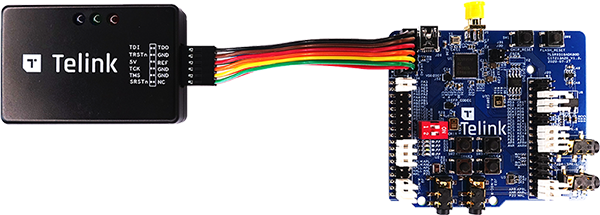The Telink All Clusters Minimal Example Application implements various ZCL clusters populated on three endpoints. You can use this example as a reference for creating your own application.

The example supports building and running on the following devices:
| Board/SoC | Build target | Zephyr Board Info |
|---|---|---|
| B91 TLSR9518ADK80D | tlsr9518adk80d, tlsr9518adk80d-mars, tlsr9518adk80d-usb | TLSR9518ADK80D |
| B92 TLSR9528A | tlsr9528a, tlsr9528a_retention | TLSR9528A |
| B95 TLSR9258A | tlsr9258a | TLSR9258A |
| W91 TLSR9118BDK40D | tlsr9118bdk40d | TLSR9118BDK40D |
Run the Docker container:
$ docker run -it --rm -v $PWD:/host -w /host ghcr.io/project-chip/chip-build-telink:$(wget -q -O - https://raw.githubusercontent.com/project-chip/connectedhomeip/master/.github/workflows/examples-telink.yaml 2> /dev/null | grep chip-build-telink | awk -F: '{print $NF}')
You can find the compatible Docker image version in the file:
$ .github/workflows/examples-telink.yaml
Activate the build environment:
$ source ./scripts/activate.sh -p all,telink
Build the example (replace <build_target> with your board name, see Supported devices):
$ west build -b <build_target>
Also use key -DFLASH_SIZE, if your board has memory size different from 2 MB, for example, -DFLASH_SIZE=1m or -DFLASH_SIZE=4m:
$ west build -b <build_target> -- -DFLASH_SIZE=4m
You can find the target built file called zephyr.bin under the build/zephyr directory.
Flash binary:
$ west flash --erase
To get output from device, connect UART to following pins:
| Name | Pin |
|---|---|
| RX | PB3 (pin 17 of J34 connector) |
| TX | PB2 (pin 16 of J34 connector) |
| GND | GND |
Baud rate: 115200 bits/s
The following buttons are available on tlsr9518adk80d board:
| Name | Function | Description |
|---|---|---|
| Button 1 | Factory reset | Perform factory reset to forget currently commissioned Thread network and return to a decommissioned state (to activate, push the button 3 times) |
| Button 2 | Not used | Not used |
| Button 2 | Not used | Not used |
| Button 4 | Open commission window | The button is opening commissioning window to perform commissioning over BLE |
Red LED indicates current state of Thread network. It is able to be in following states:
| State | Description |
|---|---|
| Blinks with short pulses | Device is not commissioned to Thread, Thread is disabled |
| Blinks with frequent pulses | Device is commissioned, Thread enabled. Device trying to JOIN thread network |
| Blinks with wide pulses | Device commissioned and joined to thread network as CHILD |
Build chip-tool cli
Pair with device
${CHIP_TOOL_DIR}/chip-tool pairing ble-thread ${NODE_ID} hex:${DATASET} ${PIN_CODE} ${DISCRIMINATOR}
Example:
./chip-tool pairing ble-thread 1234 hex:0e080000000000010000000300000f35060004001fffe0020811111111222222220708fd61f77bd3df233e051000112233445566778899aabbccddeeff030e4f70656e54687265616444656d6f010212340410445f2b5ca6f2a93a55ce570a70efeecb0c0402a0fff8 20202021 3840
OTA feature enabled by default only for ota-requestor-app example. To enable OTA feature for another Telink example:
After build application with enabled OTA feature, use next binary files:
All binaries has the same SW version. To test OTA “matter.ota” should have higher SW version than base SW. Set CONFIG_CHIP_DEVICE_SOFTWARE_VERSION=2 in corresponding “prj.conf” configuration file.
Usage of OTA:
Build the Linux OTA Provider
./scripts/examples/gn_build_example.sh examples/ota-provider-app/linux out/ota-provider-app chip_config_network_layer_ble=false
Run the Linux OTA Provider with OTA image.
./chip-ota-provider-app -f matter.ota
Provision the Linux OTA Provider using chip-tool
./chip-tool pairing onnetwork ${OTA_PROVIDER_NODE_ID} 20202021
here:
Configure the ACL of the ota-provider-app to allow access
./chip-tool accesscontrol write acl '[{"fabricIndex": 1, "privilege": 5, "authMode": 2, "subjects": [112233], "targets": null}, {"fabricIndex": 1, "privilege": 3, "authMode": 2, "subjects": null, "targets": null}]' ${OTA_PROVIDER_NODE_ID} 0
here:
Use the chip-tool to announce the ota-provider-app to start the OTA process
./chip-tool otasoftwareupdaterequestor announce-otaprovider ${OTA_PROVIDER_NODE_ID} 0 0 0 ${DEVICE_NODE_ID} 0
here:
Once the transfer is complete, OTA requestor sends ApplyUpdateRequest command to OTA provider for applying the image. Device will restart on successful application of OTA image.